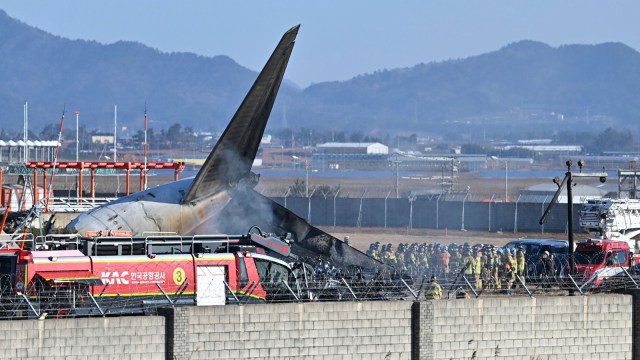Stay updated with the latest - Click here to follow us on Instagram
Tragedy in the skies: As Jeju Air flight crashes at South Korea airport, a look at the deadly accidents in last 5 years
The South Korean flight Jeju Air, said to be a Boeing 737-800, was carrying 181 passengers and six crew members onboard.
 Firefighters and rescue team members work on the runway of Muan International Airport in Muan, South Korea. (AP)
Firefighters and rescue team members work on the runway of Muan International Airport in Muan, South Korea. (AP)A flight from Thailand to South Korea’s Muan International Airport turned fatal for scores of people after the plane veered off the runway and burst into flames early Sunday. The crash has resulted in the death of 120 people so far.
The flight, said to be a Boeing 737-800, was carrying 181 passengers and six crew members and was returning from Thailand’s capital Bangkok.
This is one of the many devastating plane crashes that have shocked the world in the last few years. Here, we examine some of the most catastrophic accidents over the past five years:
BREAKING: Death toll in South Korea plane crash rises to 47, more than 130 people still unaccounted for https://t.co/9DTMqyGoC0
— BNO News (@BNONews) December 29, 2024
Lion Air Flight 610: The Rise and Fall of the 737 MAX
One of the most talked-about crashes in the past five years was Lion Air Flight 610, which plunged into the Java Sea on October 29, 2018, shortly after taking off from Jakarta, Indonesia. The Boeing 737 MAX 8 aircraft, a new addition to the fleet, was en route to Pangkal Pinang, carrying 189 people. All passengers and crew members passed away.
 Firefighters and rescue team members work at Muan International Airport in Muan, South Korea, Sunday, Dec. 29, 2024. (Photo: AP)
Firefighters and rescue team members work at Muan International Airport in Muan, South Korea, Sunday, Dec. 29, 2024. (Photo: AP)
The investigation into the crash revealed that a malfunction in the aircraft’s Maneuvering Characteristics Augmentation System (MCAS) led to the plane’s fatal descent. The MCAS, designed to prevent the plane from stalling, was activated by faulty sensor readings, pushing the nose of the aircraft down repeatedly, despite the pilots’ attempts to counteract it. The crash prompted an unprecedented global grounding of the 737 MAX, with over 370 of the aircraft type grounded worldwide. The tragedy highlighted serious flaws in both Boeing’s aircraft design and the oversight by aviation regulators, particularly the Federal Aviation Administration (FAA), which had certified the aircraft despite knowing about its issues.
This crash was the first in a series of deadly incidents involving the 737 MAX, and it played a pivotal role in transforming aviation safety standards. It led to intense scrutiny of Boeing’s practices, and the eventual overhaul of the 737 MAX’s software and flight control systems.
Ethiopian Airlines Flight 302: Another Fatal 737 MAX Disaster
Barely five months after the Lion Air crash, another Boeing 737 MAX went down. Ethiopian Airlines Flight 302 crashed on March 10, 2019, shortly after takeoff from Addis Ababa, Ethiopia, killing all 157 people aboard. The similarities to the Lion Air disaster were immediate, with investigators again pointing to the MCAS system as the cause.
The Ethiopian Airlines tragedy not only caused a second loss of life involving the 737 MAX but also further deepened the crisis surrounding the aircraft. In response, aviation authorities around the world grounded the MAX again, and Boeing faced mounting legal and financial pressure. While the cause of the crash was traced to similar issues with the MCAS system, it also led to an examination of pilot training and whether crew members were adequately prepared to handle such a malfunction.
 Rescuers at the scene of an Ethiopian Airlines flight crash near Bishoftu, or Debre Zeit, south of Addis Ababa, Ethiopia. (AP/ File Photo)
Rescuers at the scene of an Ethiopian Airlines flight crash near Bishoftu, or Debre Zeit, south of Addis Ababa, Ethiopia. (AP/ File Photo)
In the aftermath, Ethiopia and other countries called for greater transparency from manufacturers and regulators alike. Ethiopian Airlines, one of Africa’s largest carriers, also came under scrutiny for its handling of maintenance protocols, though the airline’s fleet had a good safety record before the crash. Boeing would later pay billions in settlements, and the 737 MAX was grounded worldwide until modifications were made to its systems.
Sriwijaya Air Flight 182: A Mystery in the Sky
On January 9, 2021, Sriwijaya Air Flight 182, a Boeing 737-500, crashed into the sea shortly after departing from Soekarno-Hatta International Airport in Jakarta, Indonesia. The flight, bound for Pontianak, crashed into the ocean minutes after takeoff, killing all 62 people on board. This crash marked one of the deadliest aviation incidents in Indonesia in recent years.
The investigation revealed that the crash was caused by a combination of mechanical failure and human error. A malfunction in the aircraft’s auto-throttle system caused the plane’s engines to become unbalanced, leading to an uncontrollable roll and eventual dive into the water. In this case, pilot error also played a significant role, with the pilots failing to respond adequately to the situation.
While the aircraft had been well-maintained, the investigation raised concerns about the readiness of some Indonesian carriers to handle older aircraft types, as well as the training protocols for handling emergency situations. The crash underscored the importance of maintaining and upgrading older aircraft in service, as well as ensuring that all airline personnel are thoroughly trained to respond to mechanical failures.
Pakistan International Airlines Flight 8303
On May 22, 2020, Pakistan International Airlines (PIA) Flight 8303, an Airbus A320, crashed into a residential area in Karachi, Pakistan, during its second attempt at landing at Jinnah International Airport. The flight, which had departed from Lahore, was carrying 99 passengers and eight crew members. The crash resulted in 41 fatalities, with dozens more injured on the ground.
Preliminary investigations revealed that the crash was caused by pilot error during the landing approach. The aircraft had attempted to land, but due to issues with the landing gear, the plane scraped the runway, damaging its engines. Despite this, the pilots continued the approach, ultimately losing control and crashing into the residential area. The plane’s black box revealed that the pilots did not follow standard emergency procedures, exacerbating the situation.
This crash revealed deep flaws in pilot training and regulatory oversight. The investigation led to an inquiry into the quality of training at the Pakistan Civil Aviation Authority, with findings that suggested widespread issues with certification and safety protocols. It also raised concerns about PIA’s overall safety culture, which had been criticized even before the crash.
Air India Express Flight 1344
On August 7, 2020, Air India Express Flight 1344 crashed while attempting to land at Kerala’s Kozhikode International Airport, killing 21 people. The flight, coming from Dubai, had a total of 165 people on board. The aircraft skidded off the wet runway, fell into a valley, and broke apart.
Investigators found that the crash was the result of a combination of weather-related conditions, human error, and poor runway infrastructure. The aircraft landed on a runway that was too short for the heavy monsoon rain and the plane’s length. This led to the plane skidding off the runway and ultimately falling into the valley below. The pilots’ decision to continue the landing despite the hazardous conditions was scrutinized, with experts arguing that a diversion to another airport might have been a safer option.
The incident highlighted the challenges of flying during the monsoon season in India, where unpredictable weather can pose significant risks to pilots. Additionally, the accident prompted a review of airport infrastructure in India, especially the condition of runways and the adequacy of runway overrun areas, which may have helped prevent the tragic accident.
China Eastern Airlines Flight MU5735
On March 21, 2022, China Eastern Airlines Flight MU5735, a Boeing 737-800, crashed in the mountains of southern China, killing all 132 people aboard. The crash occurred during the aircraft’s descent from cruising altitude and is still the subject of extensive investigation.
The black box data revealed that the aircraft’s descent was rapid and deliberate. Early speculation focused on whether the crash was the result of a mechanical failure or human intervention. While investigators were initially cautious, reports later suggested that pilot actions might have contributed to the crash. However, the full investigation remains ongoing, and the true cause of the disaster is still not clear.
Saurya Airlines crash in Nepal
A Saurya Airlines plane had crashed on July 24 with 15 passengers and four crew members on board during its takeoff from the Tribhuvan International Airport in Kathmandu.
The plane, a 50-seater Bombardier CRJ-200 jet, was bound to Pokhara when it veered off the runway and burst into flames. All on board died except the pilot, Captain Manish Ratna Shakya, who was saved and became the lone survivor of the crash.
Voepass Airline crash in Brazil
A plane carrying 62 people had crashed outside of the city of Sao Paulo, with all people reported dead in the accident. The Brazilian airline Voepass 2283, an ATR 72 twin-engine turboprop, which was headed for Sao Paulo’s international airport carrying 58 passengers and four crew members, went down on August 9.
Lieutenant Colonel Carlos Henrique Baldi of the Brazilian air force’s centre for the investigation and prevention of air accidents had told media that it was early to have confirmed ice as the reason for the crash. Since local media had reported icing as the potential cause of the plane crash.
Azerbaijan Airlines crash in Kazakhstan
An Azerbaijan Airlines plane crashed in Kazakhstan killing 38 people on board on December 25. The flight was carrying 62 passengers and five crew members and it was en route to Grozny in Russia from Baku, when it crashed near the Caspian Sea.
Meanwhile, on Saturday, the Kremlin accepted that the plane was downed by the Russian air defence forces which were repelling a series of Ukrainian drone attacks.
“The Azerbaijani passenger aircraft, which was travelling according to its schedule, repeatedly tried to land at Grozny airport. At that time, Grozny, Mozdok and Vladikavkaz were being attacked by Ukrainian unmanned aerial vehicles, and Russian air defense systems repelled these attacks,” the Kremlin said.
Photos



- 01
- 02
- 03
- 04
- 05




























